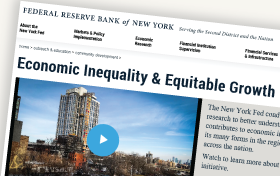Banks’ Balance‑Sheet Costs and ON RRP Investment

Daily investment at the Federal Reserve’s Overnight Reverse Repo (ON RRP) facility increased from a few billion dollars in March 2021 to more than $2.3 trillion in June 2022 and has stayed above $2 trillion since then. In this post, which is based on a recent staff report, we discuss two channels—a deposit channel and a wholesale short-term debt channel—through which banks’ balance-sheet costs have increased investment by money market mutual funds (MMFs) in the ON RRP facility.
What Quantity of Reserves Is Sufficient?
A concern of the Federal Reserve is how to manage its balance sheet and whether, over the long run, the balance sheet should be small or large. In this post, we highlight results from a recent paper in which we show how, even during a period of “ample” reserves, the Fed’s management of its balance sheet had material impacts on funding markets and especially the repo market. We argue that the Fed’s “balance-sheet normalization” from March 2017 to September 2019—under which aggregate reserves declined by more than $950 billion—combined with post-crisis liquidity regulations, stressed the intraday management of reserves of large bank holding companies that are active in wholesale funding markets resulting in higher repo rates and spikes in such.
The Fed’s Balance Sheet, Night Lights, and the Other Top LSE Posts of 2017

In the spirit of this season of year-end lists of accomplishments, Liberty Street Economics offers a roundup of our most viewed posts. Our readers continued to gravitate toward timely, topical posts; our most popular explained how the Fed manages its enlarged balance sheet—a major focus of the FOMC, Congress, markets, and economists. Prompted by reader questions in response to their first post, the authors also penned a follow-up post. Another hit this year described an innovative indicator of economic growth—night light intensity measured via satellite—and used it to fact-check official Chinese growth estimates.
A Closer Look at the Fed’s Balance Sheet Accounting

An earlier post on how the Fed changes the size of its balance sheet prompted several questions from readers about the Federal Reserve’s accounting of asset purchases and the payment of principal by the Treasury on Treasury securities owned by the Fed. In this post, we provide a more detailed explanation of the accounting rules that govern these transactions.
How the Fed Changes the Size of Its Balance Sheet: The Case of Mortgage‑Backed Securities

In our previous post, we considered balance sheet mechanics related to the Federal Reserve’s purchase and redemption of Treasury securities. These mechanics are fairly straightforward and help to illustrate the basic relationships among actors in the financial system. Here, we turn to transactions involving agency mortgage-backed securities (MBS), which are somewhat more complicated. We focus particularly on what happens when households pay down their mortgages, either through regular monthly amortizations or a large payment covering some or all of the outstanding balance, as might occur with a refinancing.
How the Fed Changes the Size of Its Balance Sheet

The size of the Federal Reserve’s balance sheet increased greatly between 2009 and 2014 owing to large-scale asset purchases. The balance sheet has stayed at a high level since then through the ongoing reinvestment of principal repayments on securities that the Fed holds. When the Federal Open Market Committee (FOMC) decides to reduce the size of the Fed’s balance sheet, it is expected to do so by gradually reducing the pace of reinvestments, as outlined in the June 2017 addendum to the FOMC’s Policy Normalization Principles and Plans. How do asset purchases increase the size of the Fed’s balance sheet? And how would reducing reinvestments reduce the size of the balance sheet? In this post, we answer these questions by describing the mechanics of the Fed’s balance sheet. In our next post, we will describe the balance sheet mechanics with respect to agency mortgage-backed securities (MBS).
Transparency and Sources of Information on the Federal Reserve’s Operations, Income, and Balance Sheet
This week-long series examined the evolution of the Federal Reserve’s securities portfolio and its performance over time.
What If? A Counterfactual SOMA Portfolio
The Federal Open Market Committee (FOMC) has actively used changes in the size and composition of the System Open Market Account (SOMA) portfolio to implement monetary policy in recent years.
A History of SOMA Income
Historically, the Federal Reserve has held mostly interest-bearing securities on the asset side of its balance sheet and, up until 2008, mostly currency on its liability side, on which it pays no interest.
The SOMA Portfolio through Time
The System Open Market Account (SOMA) is a portfolio held by the Federal Reserve to support monetary policy implementation and reflects assets and liabilities (domestic, and some foreign) acquired through open market operations.














 RSS Feed
RSS Feed Follow Liberty Street Economics
Follow Liberty Street Economics